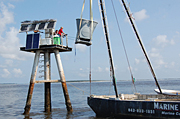- Number 321 |
- September 27, 2010
Testing the wind off the South Carolina coast

Second Wind’s Triton® Sonic
Wind Profiler, which uses
sound detection and ranging
(SODAR) technology.
On a U.S. Coast Guard platform off the coast of Georgetown, S.C., DOE's Savannah River National Laboratory (SRNL), the Clemson University Restoration Institute (CURI), and their partners have begun testing technology to provide insight into how much energy potential South Carolina’s offshore winds offer. The ultimate goal is the deployment of offshore wind energy technology to diversify the region’s energy resources and significantly increase its energy independence.
The Eastern seaboard has one of the largest untapped supplies of wind energy (currently one of the most cost effective renewable energy sources) in the United States. It has been estimated that South Carolina alone could produce up to 3.5 GW of power from its coastal and offshore wind resources using existing technology. Capturing less than 3 percent of this potential would reduce greenhouse gas emissions by 1.2 to 2.5 M tons per year and up to 16K tons of SO2 emissions.
Before the region can make use of this wind, however, it is necessary to find out its potential as a cost-effective, practical energy source. SRNL, CURI and partners –Clemson University’s S.C. Institute for Energy Studies, Coastal Carolina University, Center for Hydrogen Research, and the U.S. Coast Guard – are part of the South Carolina Consortium for Offshore Wind. This consortium will study South Carolina’s coastal winds to determine the viability of developing the state’s first offshore wind farm.
The team has installed Second Wind’s Triton® Sonic Wind Profiler, which uses sound detection and ranging (SODAR) technology, on an offshore Coast Guard platform to study SODAR technology’s potential as an offshore wind measurement tool. SODAR, which measures wind movement by detecting its effect on sound waves, provides wind measurements at a much greater range of altitudes than traditional meteorological towers. The technology can measure wind speed, direction, and other characteristics at heights extending up to 200 meters, compared to a typical 60-meter meteorological tower.
“The use of SODAR could reduce the cost of offshore wind energy exploration, significantly improve offshore wind energy forecasts, and accelerate the offshore wind energy development,” said Ralph Nichols, who leads SRNL’s wind initiatives.
Although SODAR technology has been in use for other types of atmospheric measurements for a number of years, the SRNL-CURI project is the first use of remote sensing technology to measure wind offshore on the Atlantic seaboard. It is also the first offshore use of Second Wind’s Triton.
On the platform, the team will test and evaluate the SODAR technology’s compatibility with ocean conditions. They will also develop calculations to correct for movement caused by ocean waves, and study the impact of the ocean’s acoustic environment on the station’s operation. Data will be collected from the platform for one year to better understand the wind characteristics along the transitional area from offshore to the coast.
Prior to installation on the offshore platform, the SODAR station was tested at the Savannah River Site near Aiken, S.C., then on an island near Georgetown. Those tests confirmed that the SODAR station’s performance was equivalent to traditional anemometers and established a coastline reference point for the offshore test site.
As part of this project, the partners have also installed small wind turbines at five high schools and the Center for Hydrogen Research in Aiken, S.C., where much of SRNL’s energy research and development is located. These are intended as permanent installations to educate communities about wind power, and understand their concerns regarding its use.[Angeline French, 803/725-2854,
Angeline.French@srs.gov]
